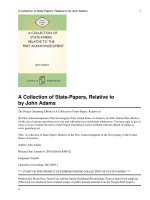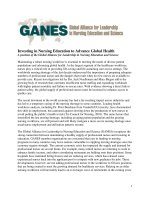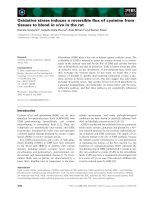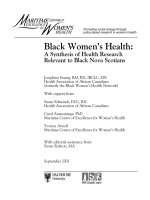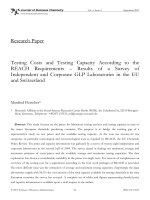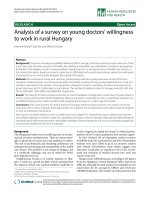A symposion of praise horace returns to lyric in odes IV
Bạn đang xem bản rút gọn của tài liệu. Xem và tải ngay bản đầy đủ của tài liệu tại đây (1.46 MB, 348 trang )
Classics / Literature & Criticism / Poetr y
Horace Returns to Lyric in Odes IV
Timothy Johnson
Johnson
A Symposion of Praise
T
“A wonderfully complex and nuanced picture of Horace’s poetry.”
—Patricia A. Rosenmeyer, University of Wisconsin–Madison
“A distinctive and original contribution to Horatian studies. It achieves a striking
new theoretical conceptualization of traditional issues and is imbued with a sense
of subtlety and humor appropriately Horatian in spirit.”
—Eleanor Leach, Indiana University
A Symposion of Praise
en years after publishing his first collection of lyric poetry, Odes I–III, Horace
(65 B.C.–8 B.C.) returned to lyric and published another book of fifteen odes, Odes
IV. These later lyrics, which praise Augustus, the imperial family, and other political
insiders, have often been treated more as propaganda than art. But in A Symposion of
Praise, Timothy Johnson examines the richly textured ambiguities of Odes IV that elevate
the book beyond propaganda and engage the audience in the communal or “sympotic”
formulation of Horace’s praise. Through this wider lens of Horatian lyric, Johnson
provides a critical reassessment of the nature of public and private in ancient Rome.
A Symposion of Praise will be of interest to historians of the Augustan period and its
literature and to scholars interested in the dynamics between personal expression and
political power.
Symposion
of Praise
Horace Returns to Lyric in Odes IV
Timothy Johnson is associate professor of classics at the University of Florida.
Wisconsin Studies in Classics
William Aylward, Nicholas D. Cahill,
and Patricia A. Rosenmeyer, General Editors
Cover Illustration: White Kylix representing Apollo
offering a libation, 480–470 B.C.
Cover Design: John Huston Graphic Design
0-299-20744-7
WISCONSIN
The University of Wisconsin Press
Madison, Wisconsin
www.wisc.edu/wisconsinpress
T I M OT H Y J O H N S O N
Winner of a CHOICE 2005 Outstanding Academic Book Award
A Symposion of Praise
A Symposion
of Praise
Horace Returns to Lyric in Odes IV
Timothy S. Johnson
T h e
U n i v e r s i t y
o f
W i s c o n s i n
P r e s s
The University of Wisconsin Press
1930 Monroe Street
Madison, Wisconsin 53711
www.wisc.edu/wisconsinpress/
3 Henrietta Street
London WC2E 8LU, England
Copyright © 2004
The Board of Regents of the University of Wisconsin System
All rights reserved
5
4
3
2
1
Printed in the United States of America
Publication of this volume has also been made possible in large part through the generous
support and enduring vision of Warren G. Moon.
Library of Congress Cataloging-in-Publication Data
Johnson, Timothy S.
A symposion of praise: Horace returns to lyric in Odes IV / Timothy S. Johnson.
p. cm—(Wisconsin studies in classics)
Includes bibliographical references and index.
ISBN 0-299-20740-4 (hardcover: alk. paper)
1. Horace. Carmina. Liber 4. 2. Laudatory poetry, Latin—History and criticism.
3. Lyric poetry—History and criticism. 4. Odes—History and criticism. 5. Rome—In
literature. 6. Praise in literature. I. Title. II. Series.
PA6411.J57 2005
874Ј.01—dc22
2004025227
ISBN 0-299-20744-7 (pbk. : alk. paper)
For Kathryn Renee Johnson
Contents
Acknowledgments
Abbreviations
ix
xi
Introduction
xiii
1. Sympotic Horace
Looking Back
Levis et Gravis
Parties and Politics
Sympotic Horace’s Epic Criticism
Sympotic Horace Exiled: Epistle II.2 and Odes IV.1
3
3
6
12
14
26
2.
40
3.
Encomia Nobilium and Horace’s Panegyric Praxis
C.1 and 2: Great Expectations? Inventing
Panegyric Discord
C.3 and 6: The Poet among the Nobiles
C.7: Panegyric and Politics, Putting Off Heirs
C.8 and 9: As the Wor(l)d Turns, Praise and Blame
Encomia Augusti, “Take One”
C.4: EpinikionOne —The Panegyric Agon
C.5: A Panegyric TagOne —All in the Family
vii
43
51
69
74
94
95
114
viii
Contents
4. Songs of Mo(u)rning
C.10: Faces in the Mirror: Ligurinus, Horace,
and Vergil
C.11: The Phyllis Odes and the Comic Power
of Shared Lyric
C.12: Vergilius at the Symposion
C.13: E/motive Song, The Art of Writing Off Lyce
5.
Encomia Augusti, “Take Two”
C.14: EpinikionTwo —Winners and Losers
C.15: A Panegyric TagTwo —“I Really Wanted To!”
Notes
Works Cited
General Index
Index Locorum
134
138
145
158
167
181
182
198
215
279
301
309
Acknowledgments
A scholar once whispered in my ear, “It can be hard to explain
what you do for a living, when your art is no more than taking
from one book and putting it in another.” There may be more to
this “art” than appears, but I am still sure that Horace would prefer that we simply read his poems. “Horace, if my art (reading) in
any way detracts from yours I apologize. I was just not up to such
a grand lyric task.”
My reading of Horace owes mentors: Brent Sandy, Jane Phillips, Robert Rabel, G. M. Browne and his sharp critical eye, and
foremost J. K. Newman, whose works on Alexandrianism and on
the epic tradition are never far from mind. Other readers have
commented and corrected at various stages of construction:
Michael von Albrecht, Andrew Becker, Randall Childree, Jeff
Fish, Kirk Freudenburg, Philip Hardie, Dan Hooley, David Konstan, Hans Mueller, Jennifer Rea, Alden Smith, Carol Staup, and
Robert Wagman. I have learned much from their discussions and
benefited from their friendship. A special thanks to Eleanor Leach
and Michèle Lowrie, the readers for the University of Wisconsin
Press, who generously offered their insights—not to mention the
errors they prevented. All that remain, of course, are my responsibility. The Press has been the model of professionalism from Patricia Rosenmeyer and her kind interest in my project to the editors Raphael Kadushin, Erin Holman, and Jane Curran, without
whom this manuscript would not have become a book.
Many have shown to me the best side of ajkadhmiva. My colleagues and friends in classics at the University of Florida have
answered many requests for advice—Gareth Schmeling, Lewis
ix
x
Acknowledgments
Sussman, and Mary Ann Eaverly more than their fair share. A
grant from the Humanities Council (University of Florida) provided funding for work in Rome. Father Raffaele Farina (Vatican
Library), Christina Huemer (American Academy at Rome), and
Bruce Swann (University of Illinois) made available their libraries’ fine collections. Friends at Baylor University, in particular William Cooper and Alden Smith (again), and at the University of Texas, David Armstrong and Tim Moore, have given
invaluable support and encouragement. Janet and Tom Lane
(and Bev) offered room and board to an itinerant scholar. I have
been blessed with five brothers, all avid and witty readers (thanks
to our mother). Deserving special mention are Galen, whose own
scholarship inspired me, and Dwayne, who has taught me how,
or at least how I would like, to live.
Animae dimidia meae—Pam, Love, if I had the talent to write an
ode, it would be for you. To my daughter, Katie, I dedicate this
book.
Abbreviations
ANRW
A.P.
CIL
EGF
FGrH
Gent.
G.-P.
IG
K.-H.
LGPN
L.-P.
N.-H.
Temporini, H., and W. Haase, eds. 1972–. Aufstieg und
Niedergang der römischen Welt: Geschichte und Kultur
Roms im Spiegel der neueren Forschung. Berlin: de
Gruyter.
Anthologia Palatina
Corpus Inscriptionum Latinarum
Kinkel, G., ed. 1877. Epicorum Graecorum Fragmenta.
Leipzig: Teubner.
Jacoby, F., ed. 1923–58. Die Fragmente der griechischen
Historiker. Berlin: Weidmann.
Gentili, B., and C. Prato, eds. 1979, 1985. Poetarum
elegiacorum testimonia et fragmenta. 2 vols. Leipzig:
Teubner.
Gow, A. S. F., and D. L. Page, eds. 1965. The Greek
Anthology: Hellenistic Epigrams. 2 vols. Cambridge:
Cambridge Univ. Press.
Inscriptiones Graecae
Kiessling, A., ed. 1884. Q. Horatius Flaccus. Berlin:
Weidmann. Rev. by Heinze. Vol. 1: Oden und Epoden,
5th ed. 1908, 9th ed. 1958; vol. 2: Satiren, 6th ed. 1957;
vol. 3: Briefe, 5th ed. 1957.
Fraser, P. M., and E. Matthews, eds. 1987–. A Lexicon of
Greek Personal Names. Oxford: Clarendon.
Lobel, E., and D. L. Page, eds. 1955. Poetarum
Lesbiorum Fragmenta. Oxford: Clarendon.
Nisbet, R. G. M., and M. Hubbard. 1970, 1978. A
Commentary on Horace: Odes Book I. Oxford: Clarendon,
xi
xii
OLD
Pf.
PIR
PIR2
PLG
PMG
RE
SH
TLL
W.
Abbreviations
1970. A Commentary on Horace: Odes Book II. Oxford:
Clarendon, 1978.
Glare, P. G. W., et al., eds. 1968–82. Oxford Latin
Dictionary. Oxford: Clarendon.
Pfeiffer, R., ed. Callimachus. 1949, 1953. 2 vols. Oxford:
Clarendon.
Klebs, E., H. Dessau, and P. von Rohden, eds. 1897–98.
Prosopographia Imperii Romani Saec. I. II. III. Berlin:
Reimer.
Groag, E., A. Stein, et al., eds. 1933–. Prosopographia
Imperii Romani Saec. I. II. III. 2nd ed. Berlin: de Gruyter.
Bergk, T., ed. 1843. Poetae Lyrici Graeci. 3 vols. Leipzig:
Teubner.
Page, D. L., ed. 1962. Poeti Melici Graeci. Oxford:
Clarendon.
Wissowa, G., et al., eds. Paulys Real-Encyclopädie der
classischen Alterumswissenschaft. 1893–1980. 33 vols.
and 15 suppl. vols. Stuttgart; Munich: J. B.
Metzlersche; Druckenmüller.
Lloyd-Jones, H., P. J. Parson, et al., eds. 1983.
Supplementum Hellenisticum. Berlin: de Gruyter.
Thesaurus Linguae Latinae. 1900–. Leipzig: Teubner.
West, M. L., ed. 1971, 1972. Iambi et Elegi Graeci ante
Alexandrum Cantati. 2 vols. Oxford: Clarendon. 2nd
ed., 1989, 1992.
Journals are abbreviated according to the conventions of L’Année
Philologique. Abbreviations of the ancient authors derive from the
most recent editions of the Oxford Classical Dictionary; the Oxford
Latin Dictionary; and Liddell, Scott, and Jones, eds. A Greek-English
Lexicon.
Introduction
This is not a book on patronage. Horace tells us he is one in a circle
of poets whose patron/s are the governing elite in the developing
principate. He addresses the lead poem of his Satires and Odes I–
III to Maecenas and follows the first ode with a praise poem to
Augustus (c.2). He then honors Vergil, the senior poet who introduced him into the circle, with a propempticon (c.3) and follows
it with a sympotic invitation to Sestius, the consul suffectus of 23
B.C. (c.4). After one love song (c.5) he addresses a recusatio to another poet who supported his entrance into the circle, Varius (c.6).
By C.I.6 his coterie of friends from the trip to Brundisium (minus
Plotius, S.I.5) are all present again. Horatian poetry embodies patronage (Ahl, 1984; P. White, 1993; Bowditch, 2001). Defining the
qualities of Horace’s patronage, its socioeconomic contexts and
language, has important implications for Horace’s poetic service
or gift; nevertheless, as important as this is, it has left unexplored
much of the contents of the gift. And in spite of Putnam’s (1986)
arguments for the merits of Horace’s later lyrics, the one book
(Odes IV), which Suetonius reports was commissioned by Augustus and is devoted to panegyric song, remains the least-studied
Horatian poetry book. This book is about the contents of that gift,
Horace’s panegyric praxis in Odes IV.
When approximately five to six years after the publication of
Odes I–III Horace accepted the commission of the Carmen Saeculare (17 B.C.) and subsequently continued to compose lyric carmina
and cast these lyrics into another book of odes (13 B.C.), he undertook the vatic role of the Romanae fidicen lyrae. At least, this is how
the poet represents his audience’s perception of his later work
xiii
xiv
Introduction
(C.IV.3.23). Although it would strain the limits set by Horace’s literary environment to read back into his persona the modern
sense of poet laureate and transpose his claim into an official title,
there are major intersections between Augustan and modern literary/political contexts. Modern political theory has rediscovered the importance of story for forming and transforming shared
ideologies (Sandel, 1996). The exchange of stories as the formative
process of civic identity involves competition, a political agon.
We can well ask about our own politeiva or civitas, “Whose story
was it, is it, and whose will it be—that of the founding fathers and
their antecedents, particular presidents and public leaders, the
courts, congress, cultural movements, the people themselves
with their ideals?” The same question, “Whose story is it or
should it be?” can be asked of Horace’s songs, and the answer is
surely as complex, but I suggest a good beginning can be made by
recognizing Odes IV as a unified collection, a book, and the Horatian panegyrist as its storyteller, who engages his audience in an
interpretive dialogue rather than as an agent who persuades to
any particular point of view.
An emphasis on persuasion reflects a bias for Ciceronian rhetoric. The great orator yields the stage reluctantly. Cicero follows
the Aristotelian and Hellenistic rhetorical tradition, which posits
praise and blame, the epideictic type (Arist. Rh.1358a36–1358b8;
demonstrativum, Cic. Inv.1.7; Part.70), on propositions developed
according to commonly admitted virtues and vices (oJmologouvmena ajgaqa; kai; kakav; Isoc. Helena 11–15; Arist. Rh.1358b38–1359a5,
1362b29–1363a16; Nicol. Prog.48.20; Men. Rh. 368.1–8; Cic. Part.
71; Russell and Wilson, 1981: xix–xxiv). Cicero goes further. He
nearly dismisses panegyric as a category of rhetoric because although praise, like senatorial reports and history, makes use of
narrative and amplification, it needs no argument. Its proofs are
naturally sustained by citing evidence, for panegyric the virtues a
person practiced (de Orat.2.43–49, 65, 342–47; Part.71–72, 75–82).
Cicero distinguishes the Roman tradition of praise from the
Greek (de Orat.2.341), stating that the Roman has an unadorned
simplicity based on the witnesses to a person’s conduct. The orator may embellish or suppress particular aspects of a person’s life
(Part.73–74), but it stands to reason that there will be limits on
what a laudator can say and remain credible to an audience that
has witnessed the life praised (Men. Rh. 398.1–6). How much any
Introduction
xv
intended audience may have observed or heard about the laudandus has implications for the speaker. Maintaining a reasonable degree of believability regarding the life lived is part of what Cicero
means when he reasserts that panegyric admits only certainties
and does not introduce points of debate (Part.71: non enim dubia
firmantur, sed ea quae certa aut pro certis posita sunt augentur; see also
Cicero’s criticism of panegyric lies, Brut.62). Evidence aside, Cicero is perfectly willing to overlook such panegyric simplicity for
himself. When he asks Lucceius to author his biography (Att.4.6),
in particular his lead role in the Catilinarian conspiracy, without
blushing Cicero urges Lucceius to exaggerate, ignore history, and
go beyond the truth (Fam.5.12.2–4). He would do so himself, but
autobiography makes braggadocio too obvious. Then again . . .
Far from avoiding and suppressing disputed propositions, Horace’s praise exploits them. Consider a few Horatian panegyric
plots. Horace celebrates Maximus’s marriage to Augustus’s
cousin Marcia by praising the gentleman, over thirty years old
and an old bachelor by Roman standards, for being a great lover
(C.IV.1). Praise for Augustus’s victory over the Sygambri, a triumph never technically held, should be led by the rather poor
Pindaric imitator Iullus Antonius, while Horace stands back in
the crowd and shouts traditional acclamations (C.IV.2). The
epinikion for Drusus and Tiberius revisits an old scandal: Augustus acquired Nero’s wife and his children. Augustus raised
them well, and now Rome is in debt to Nero’s sons, who savagely
crushed the Rhaetians and Vindelicians as a lion attacks a helpless roe. Then Horace has Hannibal the liar praise Rome (C.IV.4).
Horace praises Lollius, who lost Rome’s standards, for being a
great general (C.IV.9) and praises himself as a noble (C.IV.3). Augustus’s patron deity Apollo is invoked as a violent god of epic
vengeance, and then Apollo stops Horace from composing the
martial praise he is ready to sing (C.IV.6; 15). These panegyric tensions or nuances (dubia) lie blatantly on the surface in the odes’
plots, not just hidden in their details. Horace has neither followed
the traditional guidelines transferred to Rome by Cicero and others nor set any precedent for Menander Rhetor’s precepts for panegyric. He has taken another path, more Callimachean. The twists
and turns of Horace’s encomiastic plots, the variety of their poetic
structures, and the complex allusive qualities of their narratives
preserve a Callimachean spirit. In Callimachus the Nile sings
xvi
Introduction
Sosibios’s victories in the games (fr.384 Pf.), and locks of hair
(fr.110 Pf.), vowed by Queen Berenice for the safe return of her
husband, lament war and praise their lady’s pledged steadfast
love in their own voice (Thomas, 1983). Callimachus did sing of
kings and battles and did so with an imagination not easily explained by rhetorical handbooks. Thus Alan Cameron (1995) assesses Propertius’s praise elegy (4.6): “It is the fanciful, allusive,
asymmetrical style of Callimachean epinician that lies behind
the curious Propertian experiment. All that is lacking is Callimachus’s saving irony and wit” (479; n.b. 476–83). Horace has
sustained the witty complexities in his encomia. When Propertius’s praises are placed alongside Horace’s, they are not so curious or experimental as supposed. It is certain that Plato as least
would have banished both Propertius and Horace and their
mimetic praise poetry from his city (R. 396b–d; 401b; Lg. 801e–2a;
829c–e; 957d–e). To be sure, Ovid, who would more fully exploit
the same imaginative multiplex panegyric strategy, would have
had to go.
When Lowell Edmunds (2001) puts some final nails in the coffin of authorial intention (viii), he does not excuse me from a question on whether the presence of disputed propositions (dubia) in
Horatian panegyric is different from the aporia that naturally
comes to the fore in negotiating sense with any literature. Fowler
(1997:24, 27; 2000:3–4) and Hinds (1998:48), I think rightly, position meaning in the moment of reception. What makes tensions in
Horatian panegyric different from those in hearing or reading in
general is not necessarily any clear evidence in the text of his
poems that Horace intended to include disputes, but rather that
other rhetoricians and panegyrists advise that disputes, especially conflicts that might impugn the character of the laudandus,
should be avoided. Perhaps what makes panegyric a dangerous
game is that disputes can never really be avoided (Bartsch, 1994),
and if this is the case, then I believe (just from the brief outline of
the above plots) that Horace takes on the panegyric hazards like
a daredevil. A panegyrist under a temperamental emperor would
not want Horace for his model nor would he want for his listeners or readers, an audience Horatian praise had made sensitive to
the presence of disputes. Whether we call Horace’s panegyric
“good” or “bad” depends on our own understanding of intention. We assume, too naively, that good panegyric means undis-
Introduction
xvii
puted praise for the honoree. Horace models a more nuanced
panegyric expression, more readily attributed to exilic Ovid
(Barchiesi, 1994; G. D. Williams, 1994:154–68). Edmunds’s supposedly safe concession, “Roman poets had intentions for their
poems. A most obvious one is to please a patron (19),” may have
limited value in appreciating the complexities of Horace’s panegyric storytelling.
While dismissing the rule of intention, I would argue that a
reading that discerns in Horatian panegyric an invitation to an interpreting community, that is the formation of praise through a
complex of reciprocal voices, derives from impulses within the
text and is not simply forced onto Horatian panegyric by the aporia of remote audience(s). Such aporia surely compounds the complexities of Horatian panegyric and may be confused, arguably
so, with the disputes within the text; however, these disputes are
also encouraged by the collective spirit of the panegyric. Horace’s
remodeling of Pindaric structures throughout book IV invokes
the environment of the agon in which multiple participants (athlete, judges, audience, praise singers) comprise the event. Horatian panegyric in this short collection involves a wide range of
communal experiences: weddings (c.1), triumphs (c.2), hymns
(c.3, 6, 15), familial relationships (c.4, 5, 14), and laments (c.1, 10,
11, 12). The Dionysiac ritual symbolism, prominent in c.5 but
always implicit in the poet’s sympotic persona, places wine
(poetry) inside the gathered revelers so that they are empowered
through song to celebrate life’s pleasures together. Thus the
book’s concluding invitation (c.15) is to communal song: nos . . .
canemus, ‘I’ (the poet-singer) and ‘we’ (the poet’s audiences).
These communal moments of Horatian panegyric, the experiences in our living and dying that necessitate we come together
and on some level incorporate individual expressions, position
the internal and external audiences not as passive spectators but
as active participants who create and re-create the events.
I borrow the dialect of modern public philosophy (sharing stories in the process of forming and maintaining civic identities) not
only to shorten the distance between Horace’s situation and our
own but also to provoke a conversation on Horace’s later poems
that moves beyond intention, motivation, and the problem of sincere or insincere panegyric. This move, long suggested (Galinsky,
1975:210–17; Brink, 1982:532–33; Santirocco, 1995:225–29), has
xviii
Introduction
been slow to realize. Although panegyric poetry has received
some renewed attention (MacCormack, 1981; Pernot, 1993;
Bartsch, 1994, 1998; Whitby, 1998; Fantham, 1999) due to recent
work on the later epicists, the application of panegyric modes of
thought to Odes IV has maintained the assumption that praise and
blame are mutually exclusive: the poet in total control of the creative and interpretive processes performs one act or the other.
Consequently, Horatian panegyric has been oversimplified. In
spite of Horace’s consistent imaging of himself as the new and
greater Pindar, exactly how he shapes and defines his panegyric
persona is given short shrift compared to whether he reflects imperial interests. Many still view panegyric as a negative label,
which offends us more than the poet, and approach Odes IV, via
Suetonius, wondering why Horace wrote the book in the first
place. Doubts about Suetonius’s account that Horace put together
Odes IV only because Augustus requested praise pieces for his
sons have spread from Fraenkel (1957) throughout Horatian criticism, but there continues to be an overreliance on Suetonius and
a disregard for the poet’s own ambitions and creative passions
even after the success of his Carmen Saeculare. Accepting imperial
pressure as the prime motivation for Horace’s later lyric immediately places Odes IV in a reactive posture and perpetuates the pro/anti-Augustan debate. Some hear Horace’s voice as authentic
imperial praise, fervent or less so, with little consideration of
what this implies about the poet’s role in Roman society. Others
read Horace as subversive without recognizing what might be at
risk for a poet so well known and with such powerful patrons. As
a consequence, there is still no clear unifying relationship between the so-called public (c.1–9, 14–15) and private poems (c.10–
13). The private is still completely subsumed into the political so
that certain poems are at best ignored and at worst confused.
Trends in literary theory often lead back to the same conclusions. Horace represses his voice; that is, the poet sacrifices independent expression to fulfill a public role and does his best
under these circumstances (Oliensis, 1998). Some odes “sap” the
sense of others so that the poet weakens his praise and renders it
questionable (Lyne, 1995). Although such readings avoid the negative label of propagandist, they still heavily depend on presuppositions about authorial motivation. Others have tried to escape
this quandary through metapoetics. The Callimachean and Epi-
Introduction
xix
curean aesthetic of the small or thin voice (Horatian moderatio)
contradicts the persona required for praise poetry and makes
panegyric impossible. The poet can never be believable in this
role (Fowler, 1995; and to a lesser degree Lowrie, 1997:349–52). To
be sure, Horace’s poetry is about poetry, and as Lowrie’s work
has again proven, Horatian techne is often the point—not the only
point, but a primary one. Putnam (1986) has well demonstrated
that Horace is concerned to establish the role of the poet and the
lyric poetic in Roman society. But is Horace’s lyric so limited by
encomium that poetic power can be reduced to an ability to immortalize the deeds of another? If this is the case, then Horace’s
lyric sympotic persona of Odes I–III is in full retreat in Odes IV.
Horace’s Carmen Saeculare, which presents the poet as the creator
of its ritual magic (Putnam, 2000), announces the opposite: Horace’s lyric has the power to give substance and form to civic identities. This is the impasse of Odes IV: either there is no credible Horatian imperial or Roman panegyric, or the poet is so completely
an imperial panegyrist that he is little else.
One root cause of the dilemma (as Barchiesi, 1994, has already
shown with Ovid; Habinek, 1998, with Augustan literature in
general) is that the political and aesthetic have been so artificially
divided that the lyric sympotic Horace and the panegyric Horace
are too often completely disassociated. The failure to appreciate
fully the irony of Horace’s epic criticism and the diversity of the
lyric tradition has led to the overapplication of this artificial division (when the poet is in a panegyric mode he has forfeited his independent lyric temperament). Studies on Horace have repeatedly, if inadvertently, communicated clearly the uncomfortable
friction between the pleasures of Horatian drinking songs and
imperial praise. It is so inconvenient that they together form the
same lyric collection. But the poet has been so obviously deceitful.
Horace is above all a sympotic poet, and his panegyric praxis is
best understood as an expression of his sympotic persona from
Odes I–III (chapter 1). Book IV does not stand independently from
Horace’s earlier lyric collection. From the first ode of book IV, Horace weds panegyric with his lyric sympotic persona. This is to
say that Horatian panegyric depends on an invitation to community rather than a confrontational relationship of a poet facing an
audience and attempting to persuade them to adopt a particular
position toward a laudandus. We should also expect Horatian
xx
Introduction
encomia, like Horatian symposia, to be seriocomic. As such they
are prone to incorporate conflicting points of view and tone
(chapter 2). These tensions and conflicts provoke Horace’s audience to become active interpreters, and as a result even the panegyrics for the imperial family do not offer easy resolutions between praise and blame or political and poetic power. Horace’s
lyric praise requires and nurtures a collective interpretive process
that transforms panegyric into a vibrant communal activity
(chapters 3 and 5). The communal nature of Horatian panegyric
complements the expressions of lament and celebration prominent in Odes IV. The anguish expressed over the transience of life
is not so much an autobiographical sorrow over the poet’s old age
but an individual’s genuine emotive response to the episodes of
one’s life consciously encumbered and significantly entwined
with the lives of others so as to necessitate and envalue individual expression (chapter 4). That is to say, Horace’s panegyric is
sympotic.
To answer three possible criticisms—(1) I have not arranged
the book according to particular instances of the sympotic within
the encomia of Odes IV. Although this risks weakening the overall argument, it is more important to treat each ode as a whole and
not hinder the natural development of the book by rearranging its
odes out of turn. I have not been entirely successful in preserving
the book’s linear order. The odes most affected are the encomia
Augusti (4–5, 14–15), which begin in the middle of the encomia nobilium and resume after the odes of lament (10–13). Therefore, I
have divided Horace’s imperial praise into two chapters (3 and 5)
to preserve the book’s chiastic structure. This division allows my
reading of the encomia to begin where Horace began, with the
praise of young nobles. (2) I have not attempted fixed distinctions
between “Horace, the poet’s persona, the poet, the singer, and the
speaker” because Horace constantly blurs these distinctions so
that it becomes impossible to tell when he is wearing a mask and
when not. This confusion is part of Horace’s fun. I will not ruin it.
(3) It is difficult to sort through and explain the details of Horace’s
compressed lyrics with any brevity, especially since his later
songs interact so closely with his earlier work. Such attention to
complementary repetitions in Horatian song is a necessary task
and a large part of appreciating the music in Horace’s lyric art.
Consequently, any book on Horace is forced to be Callimachean,
Introduction
xxi
both fat and thin. Horace, I believe, would enjoy this compliment.
He would still likely criticize my book for having too many words,
but not too many words on literary theory.
I have tried in the notes to convey some sense of chronology for
Horatian studies by generally citing authors according to the date
of their earliest editions. For the reader’s convenience I have referenced subsequent editions, which are commonly consulted,
under their respective authors in the list of works cited.
A Symposion of Praise



